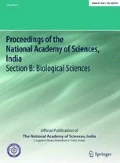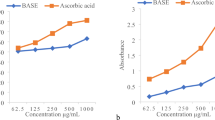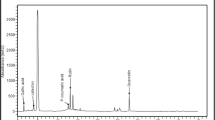Abstract
Natural colourants with bio-potential are of great commercial demands as we are moving away from the hazardous and toxic chemical dyes. Bixa orellana L. a representative of Bixaceae is rich in bixin and nor-bixin pigments which could be explored for various applications. In the present study, extraction and characterization of bixin and its associated pigment from the aril of the B. orellana L. seeds were performed using various spectroscopic techniques. Spectroscopic analysis and Gas chromatographic profiling of the pigment were performed to understand the present pigments. Toxicity was evaluated through in silico method. The major component, bixin and nor-bixin were proved to be non-toxic, non-carcinogenic and non-mutagenic through in silico methods. The pigment was found to be a potent antioxidant as well as bactericidal against opportunistic bacteria. It was found that bixin extract was a potential antioxidant and bactericidal agent. Hence it could be used for imparting bactericidal potential for cellulosic materials like papers or textiles in biomedical applications.




Similar content being viewed by others
References
Sen P (1993) Therapeutic potential of Bixa: from experience to facts. Drug News Views 1:15–21
Patnaik S, Mishra SR, Choudhary GB, Panda SK, Behera M (2011) Phytochemical investigation and simultaneously study on anticonvulsant, antidiabetic activity of different leafy extracts of Bixa orellana Linn. IJPBA 2(5):1497-01
Yong YK, Zakaria ZA, Kadir AA, Somchit MN, Ee Cheng Lian G, Ahmad Z (2013) Chemical constituents and antihistamine activity of Bixa orellana leaf extract. BMC Compl Altern Med 13:32
Selvi AT, Aravindhan R, Madhan B, Raghava Rao J (2013) Studies on the application of natural dye extract from Bixa orellana seeds for dyeing and finishing of leather. Ind Crops Prod 43:84–86
Chen HY, Yen GC (2007) Antioxidant activity and free radical scavenging capacity of extracts from guava (Psidium guajava L.) leaves. Food Chem 101(2):686–694
Zaretzki J, Matlock M, Swamidass SJ (2013) XenoSite: accurately predicting CYP- mediated sites of metabolism with neural networks. J Chem Inform Model 53(12):3373–3383
Hughes TB, Miller GP, Swamidass SJ (2015) Modeling epoxidation of drug-like molecules with a deep machine learning network. ACS Central Sci 1(4):168–180
Hughes TB, Miller GP, Swamidass SJ (2015) Site of reactivity models predict molecular reactivity of diverse chemicals with glutathione. Chem Res Toxicol 28(4):797–809
Dang NL, Hughes TB., Krishnamurthy V, Swamidass SJ (2016) A simple formula predicts UGT- mediated metabolism. Bioinformatics 32(20):3183–3189
Giridhar P, Venugopalan A, Parimalan R (2014) A review on annatto dye extraction, analysis and processing-a food technology perspectives. J Sci Res Rep 3(2):327–348
Bernard K, Grosjean M (1995) Infrared spectroscopy. In: Britton G, Liaaen-Jensen S, Fander P (eds) Carotenoid, spectroscopy, vol 1B. Birkhauser Verlag, Basel, pp 117–134
Roy RC, Steven JM, Dale RS, Fu-Hung H, Michael ST (1991) J Food Sci 56(1):80
Galindo-Cuspinera V, Lubran MB, Rankin SA (2002) Comparison of volatile compounds in water and oil soluble annatto (Bixa orellana L.) extracts. J Agric Food Chem 50(7):2010–2015
Hallagan JB, Allen DC, Borzelleca JF (1995) The safety and regulatory status of food, drug and cosmetics color additives exempt from certification. Food Chem Toxicol 33(6):515–528
Gulrajini ML, Gupta D, Ray Maulik S (1999) Studies on dyeing with natural dyes: part I-dyeing of annatto on nylon and polyester. Indian J Fiber Text Res 24(2):131–135
Sekar N (2004) Annato colorants. Colourage 51(7):67
Smith J (2006) Annato extracts- chemical and technical assessment. In: Chemical and technical assessment manual, pp 1–21
Venugopalan A, Gridhar P, Ravishankar GA (2011) Food, ethanobotanical and diversified applications of Bixa orellana L.: a scope for its improvement through biotechnological mediation. Int J Fund Appl Life Sci 1(4):9–31
Yolmeh MB, Habibi-Najafi M, Shakouri S, Hosseini F (2015) Comparing antibacterial and antioxidant activity of annatto dye extracted by conventional and ultrasound- assisted methods. Zahedan J Res Med Sci 15:29–33
Paumgartten FJR, De Carvalho RR, Araujo IB, Pinto FM, Borges OO, Souza CAM, Kuriyama SN (2002) Evaluation of the developmental toxicity of annatto in the rat. Food Chem Toxicol 40:1595-01
Shilpi JA, Taufiq-Ur-Rahman M, Uddin SJ, Alam MS, Sadhu SK, Seidel V (2006) Preliminary phramacological screening of Bixa orellana L. leaves. J Ethanopharmacol 108:264–271
Moreira PR, Maioli MA, Medeiros HCD, Guelfi M, Pereira FTV (2014) Protective effect of bixin on carbon tetrachloride-induced hepatotoxicity in rats. Biol Res 47:49
Giuliano G, Rosati C, Bramley PM (2003) To dye or not to dye: biochemistry of annatto unveiled. Trends Biotechnol 21:513–516
Acknowledgements
The authors are thankful to Department of Science and Technology, Government of India and TNSCST for providing the grant to facilitate the research [Sanction Order No. DST/SSTP/TN/2K 10/126(G) 13-09-2011]. The authors thank Management and Department of Botany and Microbiology, Lady Doak College, Madurai for providing the facilities and supporting the work.
Author information
Authors and Affiliations
Corresponding author
Ethics declarations
Conflict of interest
The authors declare that they have no conflict of interest.
Additional information
Significance statement
The pigment was derived from Bixa orellana L. found to be a potent antioxidant as well as bactericidal against opportunistic bacteria. It was found that bixin extract was a potential antioxidant and bactericidal agent. Hence it could be used for imparting bactericidal potential for cellulosic materials like papers or textiles in biomedical applications.
Electronic supplementary material
Below is the link to the electronic supplementary material.
Rights and permissions
About this article
Cite this article
Nathan, V.K., Rani, M.E., Rathinasamy, G. et al. Antioxidant and Antimicrobial Potential of Natural Colouring Pigment Derived from Bixa orellana L. Seed Aril. Proc. Natl. Acad. Sci., India, Sect. B Biol. Sci. 89, 137–143 (2019). https://doi.org/10.1007/s40011-017-0927-z
Received:
Revised:
Accepted:
Published:
Issue Date:
DOI: https://doi.org/10.1007/s40011-017-0927-z




